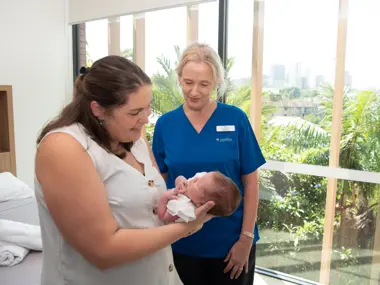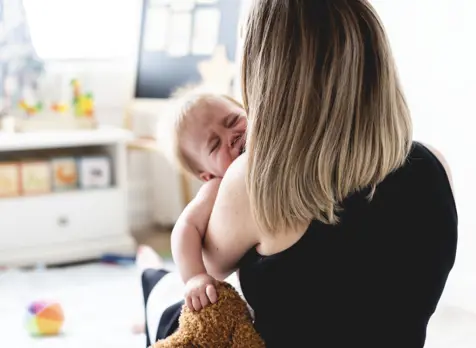Baby Crying
3 to 6 Months

Crying is one of the most difficult and heart-wrenching sounds to a parent. Crying is a signal that your baby needs your help and support.
At Tresillian, we know how tough it is to understand why you're baby is crying. Reassure yourself that it’s not your fault that your baby is going through a normal crying phase. Here you can find some ways of coping with your baby that won't stop crying. We also have some more strategies for babies that cry at bedtime or during sleep.
If you need help, you could visit your local GP or Child and Family Health Nurse or call the Tresillian Parent Help Line on 1300 272 736.
Why your 3 to 6 month old baby cries
Your baby can’t communicate their needs to you with words until well into their second year. One way they can communicate with you is through crying.
There are many reasons why your 3 to 6 month old might be screaming. Physical reasons for crying are often easier to understand. They might be:
- A nappy change
- A feed
- A sleep
- A tummy upset
- Being hot or cold
- Being uncomfortable
- Being tired
Or they may be crying because of an emotional need. This means your baby needs help to manage their feelings because they're too young to do that on their own. These feelings may include:
- Loneliness
- Anger
- Fear
- Sadness
- Overstimulation from noise or lights
- Separation from you
- Needing you to settle to sleep at bedtime or overnight
Sometimes, you may not know exactly why your baby is crying. The pitch and urgency of their cry might give you some clues.
Other ways your baby communicates
Your baby can also use facial expressions and head, legs, arms and hand movement to communicate. For example, when your baby is ready to play, they may be:
- Lifting their head and face to you
- Gazing straight into your eyes with bright, shiny and alert eyes
- Reaching to you with their arms
- Smiling
These are strong messages your baby is ready to socialise and enjoy time with you.
However there are other messages your baby may give you. For example, if your baby is overstimulated, they may be:
- Frowning
- Looking away or looking down with dull or glazed eyes
- Yawning and or mouthing hands
- Pulling at ears or rubbing head
Your baby is saying "I’ve had enough playing and I’m ready to have a break or I’m ready to stop socialising altogether". Your baby may be ready for a feed or sleep.
If those cues are missed, they may need a break or time out and become overwhelmed or distressed.
When that happens, your baby can give some strong messages to tell you they need some help to calm down and have a rest. These include:
- Turning their head away
- Starting to flap arms around
- Arching their back
- Showing you a very sad face
- Fussing
- Crying or won't stop crying
What you can do when your baby cries
When your baby shows these cues, it means they have become overloaded with stimulation and need to take a break. Here’s what you can do:
- If your baby becomes overwhelmed or distressed and shows you “I need a break” cues, it’s time to soothe and calm your baby.
- The most important thing that you can do is watch your baby carefully and follow your baby’s lead. This can give you much more information about what her non-verbal messages actually mean.
All the non-verbal cues are small moment-by-moment actions that are not always easy to identify and like all languages you have to watch closely and learn your baby’s non-verbal language.
Each cue is like hearing a single word. You can’t get meaning from one word - you have to hear a whole sentence. That’s the same for your baby’s cues.
How to respond to your baby's crying
-
1
Slow your breathing to calm yourself.
-
2
Use a soothing, slow, calm voice. You could even sing softly.
-
3
Show your baby your face and eyes.
-
4
Gently cuddle, touch, rock or sway your baby.
-
5
Be in a comfortable position that is safe for you and your baby.
-
6
Carry your baby in an approved baby carrier next to your chest and make sure you're as relaxed as you can be. Your baby will hear your heartbeat which can be soothing.
-
7
Put your baby on their back or tummy and use a gentle, rhythmic pat, rub or touch to soothe.
-
8
Take your baby for a walk in the pram.
-
9
Place your baby in a soft, firm wrap with arms flexed on chest and their hands available to suck. This helps your baby soothe.
-
10
If you use white noise or baby-safe massage oil, incorporate this into the routine.
Settling your crying baby
If your baby is ready for sleep, they might feel a bit upset initially because they're comfortable in your arms. Place them in the cot and give them a minute or two to see if they'll calm themselves. You could give them a pat to comfort them and let them know you're still there.
If your baby is still crying and is distressed, pick them up and reassure them with "you're ok". Hold them until they're calm then place them in the cot and start the process again.
FAQs for 3 to 6 month old Baby Crying
Respond to your baby through verbal and then physical reassurance. You might like to try using reassuring words as you make your way to the room, such as “It’s okay, Mummy/Daddy is on their way”.
You may need to regulate yourself by taking 2-3 deep breaths before entering the room.
On entering the room, use calm, reassuring words, and continue to talk to your baby. Tell them that you are there for them, and continue to respond as they require, with a pat, cuddle, dance or song.
Being consistent with your response will help your child learn that you will be there to meet their needs, which should help them to stop waking hysterically as they move into the next developmental stage.







































